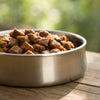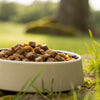How Much Should a 90 lb Dog Eat? A Comprehensive Guide for Pet Owners
- Houndsy
Table of Contents
- Introduction
- Understanding Your Dog’s Nutritional Needs
- Feeding Guidelines for a 90 lb Dog
- The Role of Houndsy in Enhancing the Feeding Experience
- Establishing a Consistent Feeding Routine
- The Importance of Hydration
- Common Mistakes to Avoid
- Conclusion
- FAQ
Introduction
Did you know that nearly 59% of dogs in the United States are considered overweight or obese? This staggering statistic highlights the importance of understanding how much to feed our furry friends, especially larger breeds like a 90 lb dog. As pet owners, we often find ourselves pondering the ideal portion sizes, nutritional needs, and feeding schedules tailored to our dogs' unique requirements.
In this blog post, we will delve into the specifics of how much a 90 lb dog should eat, considering factors such as age, activity level, and dietary needs. Our goal is to ensure that you leave with a clearer understanding of your dog's nutritional needs, enabling you to make informed decisions that promote their health and well-being.
We'll explore feeding guidelines, the significance of proper nutrition, and how Houndsy’s innovative products, like our flagship Houndsy Kibble Dispenser, can simplify the feeding process. By the end of this post, you'll have a comprehensive understanding of your dog's dietary requirements and how to provide them with the best care possible.
Understanding Your Dog’s Nutritional Needs
The Basics of Dog Nutrition
Before we dive into specifics, it's essential to grasp the foundational elements of dog nutrition. Dogs, like humans, require a balanced diet that includes:
- Proteins: Essential for growth, muscle development, and overall health.
- Carbohydrates: Provide energy and support digestion.
- Fats: Important for healthy skin and coat, and help absorb fat-soluble vitamins.
- Vitamins and Minerals: Crucial for various bodily functions, including immune health.
Daily Caloric Needs
The first step in determining how much to feed a 90 lb dog is understanding their daily caloric needs. According to veterinary experts, the average adult dog requires about 30 calories per pound of body weight for maintenance. For a 90 lb dog, this translates to:
[ 90 \text{ lbs} \times 30 \text{ calories/lb} = 2700 \text{ calories/day} ]
However, this is just a baseline. Various factors can influence the actual caloric needs of your dog.
Factors Affecting Caloric Intake
-
Activity Level: More active dogs require more calories. If your dog is a working breed or enjoys regular exercise, increase their caloric intake accordingly.
-
Age: Puppies and young dogs require significantly more calories than adults due to their growth needs, while senior dogs may require fewer calories to prevent weight gain.
-
Health Status: Dogs with specific health needs or conditions may require specialized diets under veterinary guidance.
-
Body Condition Score: This scoring system helps assess whether your dog is overweight, underweight, or at an ideal weight, allowing you to adjust their food intake accordingly.
Calculating Your Dog's Specific Needs
To get a more accurate estimate of how much food a 90 lb dog should eat, consider using the following formula:
- For Weight Maintenance: [ Weight (lbs) \times 30 = Daily Caloric Needs ]
- For Weight Loss: [ Weight (lbs) \times 20 = Daily Caloric Needs ]
- For Weight Gain: [ Weight (lbs) \times 40 = Daily Caloric Needs ]
This approach allows for more tailored feeding based on your dog's lifestyle and health goals.
Feeding Guidelines for a 90 lb Dog
Recommended Daily Feeding Amounts
Typically, dog food packaging includes feeding guidelines based on weight. For a 90 lb dog, the amount can vary depending on the brand and formulation of the dog food. However, a common range is:
- Dry Kibble: Approximately 3.5 to 4.5 cups per day.
- Canned Food: Roughly 2 to 3 cans daily.
These amounts should be divided into two meals for adult dogs to help with digestion and prevent bloating.
Importance of Quality Dog Food
Not all dog foods are created equal. When selecting a food for your 90 lb dog, consider:
- Nutritional Profile: Ensure the food contains high-quality protein sources and essential nutrients.
- Caloric Density: Some foods are more calorically dense than others; adjust portions accordingly.
- Ingredients: Look for whole ingredients rather than fillers or artificial additives.
Using a Feeding Chart
Many dog food brands provide a feeding chart on their packaging. This is a helpful starting point, but remember that individual needs may vary. Always consult with your veterinarian for personalized recommendations and adjustments based on your dog's specific health and lifestyle factors.
The Role of Houndsy in Enhancing the Feeding Experience
At Houndsy, we understand that feeding your dog should not only be about nutrition but also about convenience and enjoyment. Our flagship Houndsy Kibble Dispenser is designed to simplify and elevate the dog feeding experience, ensuring that every meal is consistent and hassle-free.
Features of the Houndsy Kibble Dispenser
- Perfect Portion Control: The dispenser allows you to control the amount of kibble dispensed, ensuring your dog receives the right portion every time.
- Standing Height Crank: Say goodbye to bending over to fill your dog’s bowl. Our ergonomic design makes feeding easy and comfortable.
- Large Storage Capacity: With a capacity of 25–30 lbs, you can store enough food for multiple meals, reducing the frequency of refills.
- BPA-Free Liner for Freshness: Our high-quality materials ensure that your dog's food stays fresh and safe.
By integrating the Houndsy Kibble Dispenser into your feeding routine, we can help you streamline your daily dog care, making mealtime a seamless part of your day. Explore the Houndsy Kibble Dispenser here.
Establishing a Consistent Feeding Routine
Frequency of Feeding
For adult dogs, feeding twice a day is generally recommended. This not only helps with digestion but also creates a sense of routine for your dog. Regular feeding times can aid in managing your dog's energy levels and behavior.
Adjusting Feeding Amounts
As your dog ages or their activity level changes, you may need to adjust their food intake. Continuously monitor their weight and body condition score, and don’t hesitate to consult with your veterinarian for tailored advice.
The Importance of Hydration
While discussing feeding amounts, we must not overlook the importance of hydration. Ensure your dog has access to fresh, clean water at all times. Hydration is crucial for overall health, digestion, and maintaining energy levels.
Common Mistakes to Avoid
-
Overfeeding: It’s easy to miscalculate portions, especially with larger breeds. Regularly assess your dog’s weight and adjust portions as necessary.
-
Ignoring Quality: Feeding low-quality dog food can lead to nutritional deficiencies and health issues. Invest in a high-quality food that meets your dog’s needs.
-
Inconsistent Feeding Schedule: Irregular feeding times can lead to behavioral issues or digestive problems. Stick to a routine for optimal results.
Conclusion
Understanding how much a 90 lb dog should eat is crucial for their health and happiness. By considering factors like age, activity level, and food quality, you can provide the appropriate nutrition that meets their unique needs.
We hope this guide has clarified the complexities of dog feeding and empowered you to make informed choices for your beloved pet. Remember, integrating practical solutions like the Houndsy Kibble Dispenser can significantly enhance your feeding experience. Order your Houndsy Kibble Dispenser today and simplify your pet care routine.
FAQ
How much should I feed my 90 lb dog if they are active?
Active dogs typically require more calories. You may need to increase their intake by about 10-20%, depending on their energy levels. Consult with your veterinarian for tailored advice.
What if my dog is overweight?
If your dog is overweight, consider reducing their caloric intake by 10-20% and consult your veterinarian for a weight management plan.
Should I feed my dog once or twice a day?
Most adult dogs do well with two meals a day. This helps manage digestion and keeps their energy levels stable throughout the day.
How can I tell if my dog is at a healthy weight?
The Body Condition Score (BCS) is a helpful tool. You should be able to feel your dog’s ribs without excess fat covering, and they should have a visible waist when viewed from above.
Can I mix wet and dry food?
Yes, mixing wet and dry food can enhance palatability and provide variety. Just be sure to adjust portions to avoid overfeeding.
By following these guidelines and investing in quality tools like the Houndsy Kibble Dispenser, we can ensure our furry friends live healthy, happy lives.












